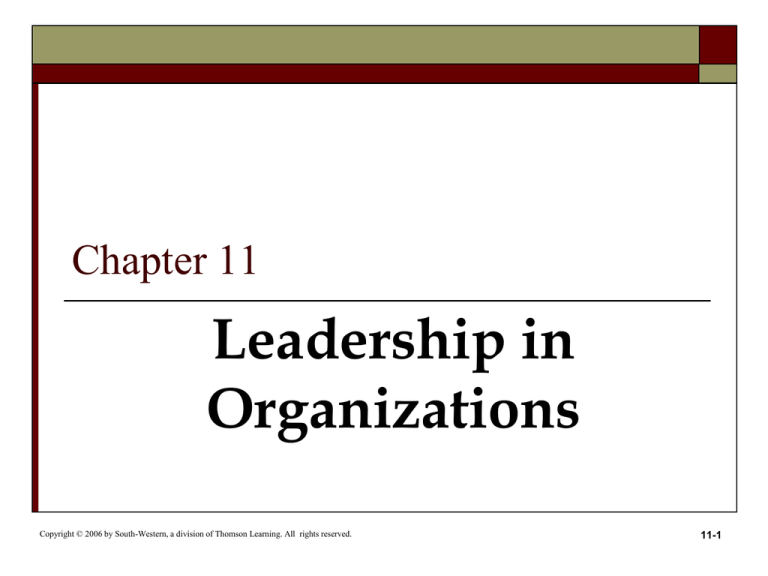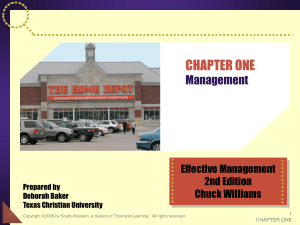
Chapter 11
Leadership in
Organizations
Copyright © 2006 by South-Western, a division of Thomson Learning. All rights reserved.
11-1
Manager vs. Leader
© 2006 by South-Western, a division of Thomson Learning. All rights reserved.
11-2
Manager vs. Leader
Manager
What Needs to be Done
Arranging People to Accomplish Goals
Planning and Budgeting
Organizing and Staffing
Ensuring People do Their Jobs
Controlling and Problem Solving
© 2006 by South-Western, a division of Thomson Learning. All rights reserved.
11-3
Manager vs. Leader
Leader
What Needs to be Done
Arranging People to Accomplish Goals
Setting a Direction
Aligning People
Ensuring People do Their Jobs
Motivating and Inspiring
© 2006 by South-Western, a division of Thomson Learning. All rights reserved.
11-4
Leadership
The ability to influence people toward the
attainment of organizational goals.
© 2006 by South-Western, a division of Thomson Learning. All rights reserved.
11-5
Ex. 11.1
Leader and Manager Qualities
SOURCE: Based on Genevieve
Capowski, “Anatomy of a Leader:
Where Are the Leaders of Tomorrow?”
Management Review, March 1994, 12.
© 2006 by South-Western, a division of Thomson Learning. All rights reserved.
11-6
Charismatic Leadership
Transactional Leaders (Non-Charismatic):
Clarify the role and task requirements of
subordinates.
Initiate structure.
Provide appropriate rewards.
Try to be considerate.
Meet the social needs of subordinates.
© 2006 by South-Western, a division of Thomson Learning. All rights reserved.
11-7
Charismatic Leadership
Transformational Leaders (Charismatic):
The ability to inspire. (Charisma)
Motivate people to do more than they would
normally do. (Creating Belief in the Company)
Individual Consideration. (Concern for
Employees)
Intellectual Stimulation. (Engages Workers to
Solve Problems)
© 2006 by South-Western, a division of Thomson Learning. All rights reserved.
11-8
Example of Transactional Leader
Gary Kelley, CEO Southwest Airlines
© 2006 by South-Western, a division of Thomson Learning. All rights reserved.
11-9
Example of Transformational Leader
Herb Kelleher, CEO Emeritus Southwest
Airlines
© 2006 by South-Western, a division of Thomson Learning. All rights reserved.
11-10
Ex. 11.2
Personal Characteristics of Leaders
Physical characteristics
Energy
Physical stamina
Intelligence and ability
Judgment, cognitive ability
Knowledge
Judgment, decisiveness
Personality
Self-confidence
Honesty and integrity
Enthusiasm
Desire to lead
Independence
Work-related characteristics
Achievement drive, desire to excel
Conscientiousness in pursuit of goals
Persistence against obstacles, tenacity
Social characteristics
Sociability, interpersonal skills
Cooperativeness
Ability to enlist cooperation
Tact, diplomatic
© 2006 by South-Western, a division of Thomson Learning. All rights reserved.
Social background
Education
Mobility
11-11
Forms of Position Power
Legitimate Power: power coming from a formal
management position.
Reward Power: stems from the authority to bestow
rewards on other people.
Coercive Power: the authority to punish or
recommend punishment.
© 2006 by South-Western, a division of Thomson Learning. All rights reserved.
11-12
Forms of Personal Power
Expert Power: leader’s special knowledge or skill
regarding the tasks performed by followers.
Referent Power: personality characteristics that
command subordinates’ identification, respect, and
admiration so they wish to emulate the leader.
© 2006 by South-Western, a division of Thomson Learning. All rights reserved.
11-13
Ex. 11.3
Concern for People
High
Low
The Leadership Grid® Figure
1,9
Country Club Management
Thoughtful attention to the
needs of people for satisfying
relationships leads to a comfortable, friendly organization
atmosphere and work tempo.
9,9
Team Management
Work accomplishment is from
committed people; interdependence
through a “common stake” in
organization purpose leads to
relationships of trust and respect.
5,5
Middle-of-the-Road Management
Adequate organization performance is
possible through balancing the necessity
to get out work with maintaining morale of
people at a satisfactory level.
Impoverished Management
Exertion of minimum effort
to get required work done
is appropriate to sustain
organization membership.
1,1
Low
Concern for Production
© 2006 by South-Western, a division of Thomson Learning. All rights reserved.
Authority-Compliance
Efficiency in operations results
from arranging conditions of
work in such a way that human
elements interfere to a minimum
degree.
9,1
High
11-14
Hersey and Blanchard’s Situational
Leadership Theory
A
contingency approach to leadership that links the
leader’s behavioral style with the task readiness of
subordinates.
Levels of readiness:
Low
Moderate
High
Very high
(Telling)
(Selling)
(Participating)
(Delegating)
© 2006 by South-Western, a division of Thomson Learning. All rights reserved.
11-15
Path-Goal Theory
Contingency approach, the leader’s responsibility is to
increase subordinates’ motivation to attain personal
and organizational goals through:
Clarifying the paths to rewards.
Increasing the rewards that the subordinate values
and desires.
© 2006 by South-Western, a division of Thomson Learning. All rights reserved.
11-16
Ex. 11.6
Leader Roles in the Path-Goal Model
SOURCE: Based on Bernard M. Bass,
“Leadership: Good, Better, Best,”
Organizational Dynamics 13 (Winter
1985),26-40
© 2006 by South-Western, a division of Thomson Learning. All rights reserved.
11-17
Path-Goal Classification of
Leader Behaviors
Supportive leadership:
Leader behavior that shows concern for subordinates.
Open, friendly, and approachable.
Creates a team climate.
Treats subordinates as equals.
© 2006 by South-Western, a division of Thomson Learning. All rights reserved.
11-18
Path-Goal Classification of
Leader Behaviors (contd.)
Directive leadership:
Tells subordinates exactly what they are supposed to do.
Planning, making schedules, setting performance goals, and behavior
standards.
© 2006 by South-Western, a division of Thomson Learning. All rights reserved.
11-19
Path-Goal Classification of
Leader Behaviors (contd.)
Participative leadership:
Consults with his or her subordinates about decisions.
Achievement-oriented leadership:
Sets clear and challenging goals for subordinates.
Behavior stresses high-quality performance.
© 2006 by South-Western, a division of Thomson Learning. All rights reserved.
11-20
Situational Contingencies
Two important situational contingencies in the
path-goal theory:
The personal characteristics of group
members.
The work environment.
© 2006 by South-Western, a division of Thomson Learning. All rights reserved.
11-21
Path-Goal Situations and
Preferred Leader Behaviors
Ex. 11.7
SOURCE: Adapted from Gary A. Yukl, Leadership in Organizations (Englewood Cliffs, N.J.: Prentice-Hall 1981), 146-152.
© 2006 by South-Western, a division of Thomson Learning. All rights reserved.
11-22
Leadership
Leadership Video
© 2006 by South-Western, a division of Thomson Learning. All rights reserved.
11-23







